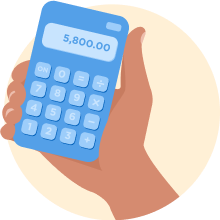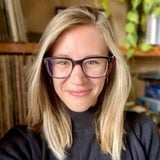What Is a Point-of-Sale (POS) System and How Does It Work?
A POS system allows businesses to accept payment from customers in person or online.

Many, or all, of the products featured on this page are from our advertising partners who compensate us when you take certain actions on our website or click to take an action on their website. However, this does not influence our evaluations. Our opinions are our own. Here is a list of our partners and here's how we make money.
Nerdy takeaways
- POS stands for point of sale, the physical or virtual location where customers pay for their purchases.
- POS systems are a combination of hardware and software that facilitates transactions. They include countertop, mobile and online options.
- Compared to traditional cash registers, modern POS systems offer additional benefits like inventory management, sales analytics and customer loyalty programs.
What is a POS system?
A POS system, or point-of-sale system, is a combination of hardware, software and payment services that businesses use to make sales. And as its name implies, this system exists at the physical or virtual point of sale. Online-only businesses, however, do not require hardware to complete their POS systems.
At minimum, a POS system records customer purchases, accepts payments and provides receipts, either by printing them or sending them electronically through text or email. Many of the best POS systems for small businesses also generate reports, help manage inventory and track employee hours, among other things.
How does a POS system work?
Think of a POS system as the modern version of a cash register. It calculates a customer's purchase amount, adds sales tax, accepts payment, logs the transaction details, and more. Here’s an overview of how a countertop POS system, in particular, helps you complete sales:

1. Ring up the total You ring up a customer’s items on your POS system by scanning their barcodes or tapping pre-programmed buttons on the system’s terminal. Then, the system calculates the purchase amount, sales tax and any applicable discounts. It may give customers the option to tip, too.

2. Accept payment The POS system’s cash drawer and/or card reader let you accept customers’ payments on the spot. If they pay with a card, your POS system’s integrated payment processing software helps facilitate the transfer of funds.

3. Print receipt After the customer’s payment is accepted, the POS system usually prints a receipt or lets you digitally send it through text or email. If your system has a loyalty program, you can ask customers if they’d like to be added to it.

4. Record data Your POS system’s software records each transaction as it happens, so that you can maintain a customer directory and run reports to hone in on average purchase amounts and your business’s busiest times of day. It should also pass that data to your accounting software.
» MORE: POS systems vs. cash registers
What does a POS system include?
Typically, the three main components of a POS system are hardware, software and payment processing services. Here’s a rundown of how each of them function.
POS hardware
Although hardware is a common component in POS systems, it isn't necessary in every case. For example, businesses that operate online only wouldn't require POS hardware.
Some POS hardware options include:
- Credit and debit card readers: Business owners who do sales in person will want to purchase, at minimum, a card reader to pair with an app on their smartphone or tablet. Some readers plug directly into the device, while others connect via Bluetooth. The best credit card readers let you swipe, tap or dip cards and may be attached to a larger, more robust POS system.
- Countertop terminals: Unlike mobile businesses, brick-and-mortar shops may need a full countertop POS setup where customers line up to make purchases. These systems usually come with larger screens, built-in card readers and optional cash drawers. There are also mobile POS systems for businesses that don’t want to be anchored to the checkout counter but need a little more than a card reader alone.
- Customer displays: Some businesses find it useful to have a separate screen to display order and payment information to the customer while the merchant handles the transaction on the opposite side of the counter. These screens can also double as digital tip jars and prompt customers to add preset gratuity amounts to their totals.
- Kitchen displays: These essentially replace the paper ticket system behind the scenes in a restaurant. Kitchen display systems (KDS) allow the front of house to send orders directly to a screen in the kitchen where staff can view, modify and track the orders.
- Self-ordering kiosks: These standalone systems empower customers to place and pay for orders on their own, freeing up staff to attend to other business needs. They don’t make sense for every business, but quick-service restaurants, in particular, tend to make use of them with positive results.
- Additional accessories: These often include cash drawers, receipt printers, barcode scanners, scales, kitchen printers and label printers.
POS software
- On-premises POS software: Sometimes known as a legacy system, this software is only accessible on the POS terminal where it’s installed. It facilitates payment processing, logs sales and labor information, and preferably syncs with accounting software. This solution often works for small businesses that prioritize in-store sales and have one POS terminal.
- Cloud-based POS software: This type of POS software syncs information from multiple POS terminals and typically offers mobile and desktop access. Cloud POS systems offer greater flexibility and may be the better solution for online businesses, mobile businesses or those with multiple terminals or locations. Clover, Square, Toast and Shopify are popular cloud-based POS system providers.
Payment processing services
For debit and credit card transactions, a payment processor is an intermediary between the merchant, the customer and financial institutions (banks). Many POS system providers double as credit card processing companies and handle card transactions. These services typically come with additional fees (more on these fees below).
🤓 Nerdy Tip
Businesses that operate entirely online and have no brick-and-mortar location generally don't need POS hardware. Their point-of-sale is their website, so they need a payment gateway, an online shopping cart or other e-commerce software. How much does a POS system cost?
Typically, the total price of a POS system involves three separate costs: the upfront hardware cost, monthly POS software fees and payment processing fees, which are usually charged on a per-transaction basis.
Here’s what you could expect to pay for each component of a POS system.
POS hardware costs: around $1,200 to $1,800 for a full setup
Pop-ups and smaller businesses or vendors that sell goods at different locations might only need a smartphone and mobile card reader as their POS hardware. This would be the least expensive hardware option, as credit card readers from some of the most common providers run from $0 (Square gives you a free magstripe reader when you sign up) to around $60 for a reader that accepts chip and contactless card payments.
If you need more than a card reader, however, hardware will be your biggest upfront cost (though some providers do offer the option to pay a higher monthly fee for both software and hardware rental). Mobile POS terminals, which accept card payments and often print receipts and scan barcodes, typically run in the range of around $240 to $630. A full register setup, which could include a customer-facing display in addition to the merchant display, card reader, cash drawer and receipt printer, tends to fall in the range of around $1,200 to $1,800.
POS software costs: $0 to around $400 per month
POS software can range from a free mobile app to a paid plan with advanced features that can include inventory management, detailed business reports and analytics, and table and menu management for restaurants. Many POS providers offer a base software plan, typically from $0 to around $400 per month (restaurant-specific software tends to be costlier than retail), along with optional add-ons such as loyalty programs (around $45 to $100), marketing tools (around $10 to $100) and online ordering (around $0 to $50).
» MORE: Best free POS software
Payment processing costs: around 1.5% to 3.5% per transaction
Payment processors charge a fee per transaction to facilitate credit card processing. The fee actually encompasses multiple fees divided among the credit card network, the bank that issues the credit card and the processor. Payment processing fees follow either a flat-rate pricing model, based on a percentage of the card payment amount plus a flat fee per transaction, or an interchange-plus model.
Total payment processing fees tend to be around 1.5% to 3.5% of the total transaction amount. Businesses typically pay more for online and card-not-present transactions compared to in-person transactions. Depending on the processor, you may also be on the hook for chargeback fees and PCI compliance fees.
Additional benefits of using a POS system
Popular POS providers offer different hardware and software packages that include features based on industry or functional needs. The best providers have multiple channels for connecting with customer support and options for integrating with accounting and tax software and popular e-commerce platforms.
- Industry-specific features: Restaurant POS systems are designed specifically for the food industry and can take reservations, assign tables to different parties, manage menus, handle tips and more. Retail POS systems offer more advanced inventory and customer relationship management features such as returns, purchase history and online orders.
- Team management: Some POS systems can help you create schedules, track hours, approve time off and sync data with payroll software.
- Reporting and analytics: Common reporting capabilities allow you to monitor sales, identify top-selling items, view monthly sales trends and build custom reports.
- Customer support: Phone and live chat-based support options are typically available to help you with the setup process and answer questions related to daily use. Some systems have support resources directly accessible through the POS device.
- Integrations: A good POS should integrate with the other software you’re using, especially your accounting, payroll and e-commerce software.
Article sources
NerdWallet writers are subject matter authorities who use primary,
trustworthy sources to inform their work, including peer-reviewed
studies, government websites, academic research and interviews with
industry experts. All content is fact-checked for accuracy, timeliness
and relevance. You can learn more about NerdWallet's high
standards for journalism by reading our
editorial guidelines.
FEATURED
More like this
Related articles








